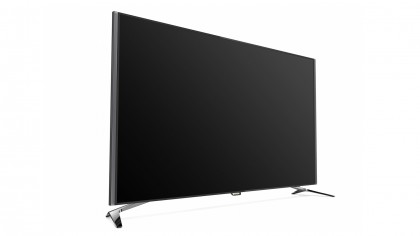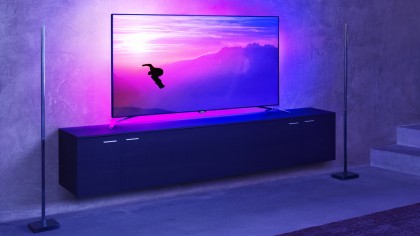TechRadar Verdict
The design of the 55PUS8601 is a delight, especially thanks to its four-sided version of Philips' Ambilight technology and ultra-slim detachable speakers. Picture performance is mostly very good, and excellent in the case of native 4K content. The experience is only marred by issues with brightness control in dark scenes.
Pros
- +
Gorgeous-looking TV
- +
Excellent audio quality
- +
Sharp, colourful pictures
- +
Relatively robust Android implementation
Cons
- -
Complicated to use
- -
Contrast isn't the best
- -
Android interface is unhelpful
- -
HDR still months away
Why you can trust TechRadar
Philips is about to unleash its biggest UK TV range in years – and the 55PUS8601 is a great statement for the brand to lead off with.
Its design instantly sets it apart as one of the most glamorous-looking TVs I've seen. It's one of the slimmest around in terms of both the narrowness of its striking screen bezel and the trimness of its rear, and the build quality is outstanding.
Its edge-mounted legs are clever, too, both for the way you hardly notice them due to their 'edge-on' appearance, and the way they provide plenty of open space along the bottom edge to enhance the TV's four-sided Ambilight effect.
Ambilight, if you're not familiar with it, uses rear-mounted LEDs to throw out coloured light beyond the TV's edges – the colours can, if you wish, be set to track the colour content of the pictures you're watching.

If you're thinking this sounds pretty in your face, I guess it is. But you can adjust both the Ambilight effect's brightness, and how aggressively it responds to changes in the content you're watching; and actually the vast majority of people who live with Ambilight for any amount of time – especially a truly comprehensive, every-side-of-the-TV Ambilight solution like the 55PUS8601 offers – quickly grow to love its immersive, eye fatigue-reducing effects.
More innovation in the 55PUS8601's design comes from its unique detachable speakers. Running the full height of the TV, these slender 'pole' speakers are finished in a gorgeous seamless dark chrome and somehow manage to house 18 speakers capable of outputting 50W, despite each of them being just 17mm wide.
They attach to the TV magnetically, or you can take them off and slot them into optional floor mounts to enjoy a wider soundstage. These floor mounts also contain some extra speakers to ramp up the soundstage's bass quotient.
Sign up for breaking news, reviews, opinion, top tech deals, and more.
Unless you really are convinced that Ambilight is just too attention-grabbing for your tastes (and the effect can be switched off if you wish), the only potential problem with the 55PUS8601's design is the way its legs sit right at the ends of the TV's bottom edge – this configuration means you'll need a piece of furniture at least as wide as the TV if you don't want your gorgeous new telly to tip over.
Screen specifications
As you'd expect of any reasonably high-end TV these days, the 55PUS8601's 55-inch screen has a native 4K/UHD pixel count of 3,840 x 2,160. But that's just the start of its charms.
Its edge LED lighting system is capable of pumping out an unusually high 700 nits of brightness, for instance, making it potentially well suited to the delivery of the new high dynamic range (HDR) picture format that's about to become a big thing in AV.

I say potentially because unfortunately Philips doesn't think it'll be able to unlock the 55PUS8601's HDR capabilities via firmware update for a good few months yet. So obviously I wasn't able to test the TV with my currently small collection of HDR sources.
With brightness being a key part of the HDR experience, though, having 700 nits to play with (versus the 350-400 nits still commonly found in the LCD TV world) will surely help the 55PUS8601 deliver HDR's brightness peaks pretty well, even if the brightness spec doesn't meet the 1000-nit minimum required by the new Ultra HD Premium recommendations.
Micro Dimming vs Local Dimming
The 55PUS8601 doesn't apply a local dimming system to its edge LED lighting, but it does boast something called Micro Dimming, which breaks the image into more than 6,000 zones for more accurate analysis and at least a degree of local manipulation.
The 55PUS8601's pictures should benefit, too, from the TV's use of Philips' Pixel Perfect Ultra HD video processing engine. This is the most potent video engine Philips currently uses, and extends its tendrils into pretty much every element of TV picture reproduction – especially colour response, detailing and motion compensation.
It's worth adding, too, that as usual Philips enables you to adjust pretty much every facet of this processing engine.
Android smarts
When it comes to smart features, the 55PUS8601 solves Philips' traditional issues with not having many apps by carrying Google's Android TV platform.
There are things about Android TV that I don't like. Its interface feels cumbersome, doesn't offer enough customisation options and doesn't work hard enough to streamline access to your favourite sorts of content.
But it does certainly offer a vast amount of apps, including the 4K-capable versions of Netflix and Amazon Instant Video.
It's important to note, too, that the Philips version of Android TV runs much more stably and slickly than the version employed on Sony's current TVs.

While the 55PUS8601 ticks most of the feature boxes I'd expect of a 2016 premium TV, though, one thing that's conspicuous by its absence is 3D support. Philips has decided to call time on 3D across its entire 2016 range, starting with the 55PUS8601, apparently on the grounds that there's not enough 3D content, people don't really want 3D, and it makes using a TV more complicated.
I have no doubt there's a passionate minority of 3D fans out there willing to take issue with Philips' decision, but the sad truth is that the majority of TV buyers probably won't even notice 3D isn't there.

John has been writing about home entertainment technology for more than two decades - an especially impressive feat considering he still claims to only be 35 years old (yeah, right). In that time he’s reviewed hundreds if not thousands of TVs, projectors and speakers, and spent frankly far too long sitting by himself in a dark room.
